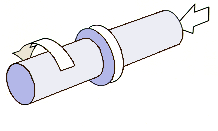|
 |
Rotary friction welding was the first of the friction processes to be developed and used commercially. No additional filler material is used and welding takes place in the solid phase, i.e. no macroscopic melting is observed. One of the inherent features of friction welding is efficient utilisation of the thermal energy developed.
There are two process variants: continuous drive rotary friction welding, and stored energy friction welding (e.g. inertia welding).
The simplest mechanical arrangement for continuous-drive rotary friction welding involves two cylindrical bars held in axial alignment. One of the bars is rotated while the other is advanced into contact under a pre-selected axial pressure (see illustration). Rotation continues for a specific time, sufficient for achieving the temperature at which metal in the joint zone is in the plastic state. Having achieved this condition, the rotating bar is stopped while the pressure is either maintained or increased to consolidate the joint.
In inertia welding, the rotating component is attached to a flywheel which is accelerated to a preset rotation speed. At this point, drive to the flywheel is cut. The rotating flywheel (with a set amount of stored energy) is then forced against the stationary component and the resultant braking action generates the required heat for welding.
The process can be used to join many similar or dissimilar metal
combinations. Difficulties can be experienced with some combinations,
however, and expert advice should be sought.
| ◄back | |
| ▼home |